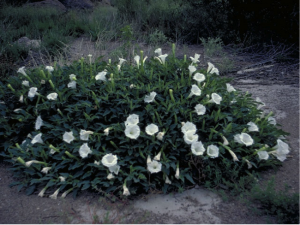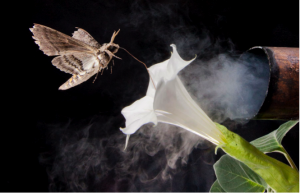The effects of anthropogenic noise and light pollution are increasingly being studied. Less studied is how anthropogenic odors can interfere with insects’ olfaction. Based on a study conducted by Riffel et al. (2014), the neural representations of important scents can be altered by anthropogenic sources like combustion engines. In order for insects to discriminate between scents, they need to distinguish between relevant odors and background odors. Riffel et al. (2014) looked at Manduca sexta moths, which pollinate Datura wrightii flowers, which grow in dense bushes that emit a high intensity odor. This odor has the same aromatic volatiles (i.e. benzaldehyde) as the flowers, which makes it more difficult for the moths to locate the odor source.

Source: http://www.wildflower.org/gallery/result.php?id_image=5472
Datura wrightii flowers grow in dense creosote bushes which emit high intensity odors that are the same odors as the flowers, interfering with odor discrimination
They used a wind tunnel and computer controlled odor stimuli to test moth responses to odor mixtures at different frequencies (odor pulses per second). They found that at the odor frequency of 1Hz, moths flew straight towards the odor source. When Riffel et al. increased the frequency of odor pulses, the moths decreased their abilities to locate the odor source, and flew in different directions. Thus, as the frequency of odor pulses increase, moths’ abilities to track odors decrease and they are not able to feed as much. This research was not limited to one odor. They also added another odor into the mixture, which decreased ability to locate the target stimulus when compared to single odor, 1Hz pulses. Odor pulses significantly affected ability to locate odor, since the moths located the target stimulus from the odor mixture better than the single target stimulus presented in quick bursts.

Source: http://www.washington.edu/news/2014/06/26/foul-fumes-derail-dinner-for-hungry-moths/ Anthropogenic odors interfere with moths’ abilities to discriminate and localize target odors from flowers. This leads to a decreased ability to pollinate.
Insects discriminate between scents neurologically via the Antennal Lobe (AL), which is a ganglion that serves the antenna and emits electrical responses from sensory stimulation in the antennae. The AL combines and processes olfactory information in the insect brain, and Riffel et al. measured responses from neurons in the AL that fired from natural olfactory stimuli. They tested this via inserting an electrode into the moth AL and recording responses to pulsed and background odor stimuli. If there were a lot of synchronized spikes to a certain odor, this suggested that the moth effectively processed it. In contrast, adding background odors to target stimuli decreased the strength of the response. It is important for odor representation and encoding odor pulses. Riffel et al. show that changing odor input into the AL changes the balance of excitation and inhibition in the structure, demonstrating its importance for identifying target odors.
Increasing the rapidity of target and background odors reduces the moth’s ability to respond to individual odors. Such background odors include anthropogenic, chemical noise from combustion engines and other sources. Obscuring the origin of odors makes difficult for pollinators to locate food sources. Since pollinators and flowers co-evolve, accurate localization is necessary for the continuation of both of the species. The decoupling of these species’ evolutions affects plants’ abilities to reproduce, thus potentially impacting crops and the larger ecosystem.
